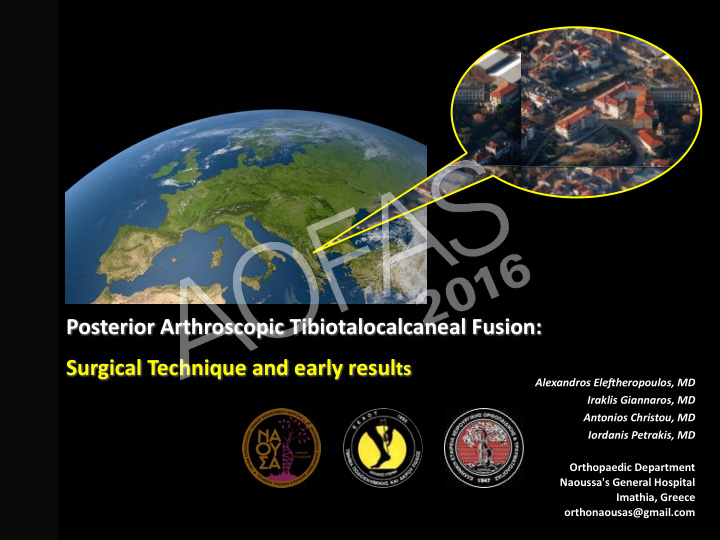



Posterior Arthroscopic Tibiotalocalcaneal Fusion: Surgical Technique and early resul ts Alexandros Ele-heropoulos, MD Iraklis Giannaros, MD Antonios Christou, MD Iordanis Petrakis, MD Orthopaedic Department Naoussa's General Hospital Imathia, Greece orthonaousas@gmail.com
Disclosure NO CONFLICT TO DISCLOSE Posterior Arthroscopic Tibiotalocalcaneal Fusion: Surgical Technique and results Alexandros Eleftheropoulos, MD Iraklis Giannaros, MD Antonios Christou, MD Iordanis Petrakis, MD Our disclosures are in the Final AOFAS Mobile App. We have no potential conflicts with this presentation.
Introduction • Hindfoot arthritis is usually treated with tibiotalocalcaneal fusion • In the vast majority there are wound problems due to previous operations • Posterior arthroscopic tibiotalocalcaneal fusion is an alternative surgical technique • Less invasive, with less morbidity • Fusion is achieved with a retrograde intra-medullary nail
Patients-methods • 5 patients: 2 � , 3 � • Age: mean 69.8 (56, 65, 71, 78,79) • 4 patients with trauma history • co morbidities – Type II diabetes in a patient • B.M.I.: mean 30,5 (24,7-36,3) • Spine anaesthesia • Thigh tourniquet • Prone position • Standard knee arthroscopic set • Fluoroscopic control
Patients-methods • Retrograde intramedullary nail T2 ankle system (Stryker)
Surgical technique - step 1 • Arthroscopic preparation of the ankle joint
Surgical technique - step 2 • insertion of the intra-medullary nail under fluroscopic - arthroscopic control • Arthroscopic preparation of the posterior facet of the subtalar joint after the insertion of the nail in order not to disturb the hindfoot alignment • Proximal and distal locking of the nail under fluoroscopic control
Postoperative protocol - Early results • 8-10/52 cast • Begin full weight bearing in 6/52 • Fusion achieved in all five cases • No major complications • Mean hospitalization 1.2 days • Fusion achieved in 3 months time (2,5-3,5)
Indications • Combined arthritis of ankle and subtalar joint • Post-traumatic arthritis – Avascular necrosis of the talus – Malleolar fracture – Pilon fracture – Os Calcis fracture • Rheumatoid arthritis • Polio • Diabetic foot (Charcot of hind foot) • Acquired flatfoot deformity (grade IV) Contraindications Varus deformity>20 ο or valgus deformity>30 ο
Discusion Advantages • Minimal invasive technique • Lower rate of nonunion – probably because of preserving vascularization – debris • Less morbidity – Hospitalization less than 3 days – no need for blood transfusion
References Technique and early experience with posterior arthroscopic tibiotalocalcaneal arthrodesis B. Devos Bevernage ∗ , P.A. Deleu, P. Maldague, T. Leemrijse Department of Orthopaedic Surgery, Cliniques Universitaires St-Luc, 10, avenue Hippocrate, B1200 Brussels, Belgium March 2010 Orthopaedics & Traumatology: Surgery & research (2010) 96, 469-475 Arthroscopic tibiotalocalcaneal arthrodesis with intramedullary nail with fins: a case series. Sekiya H, Horii T, Sugimoto N, Hoshino Y. J Foot Ankle Surg. 2011 Sep-Oct;50(5):589-92. doi: 10.1053/j.jfas.2011.04.021. Epub 2011 Jun 8. Arthroscopic tibiotalocalcaneal arthrodesis with locked retrograde compression nail. Vilà y Rico J, Rodriguez-Martin J, Parra-Sanchez G, Marti Lopez-Amor C. J Foot Ankle Surg. 2013 Jul-Aug;52(4):523-8. doi: 10.1053/j.jfas.2013.03.015. Pub 2013 Apr 20.
Recommend
More recommend